Free Dumps, Free Microsoft Dump
Free AZ-900 Dump
Question #180Topic 1
DRAG DROP –
Match the Azure services to the correct descriptions.
Instructions: To answer, drag the appropriate Azure service from the column on the left to its description on the right. Each service may be used once, more than once, or not at all.
NOTE: Each correct match is worth one point
Select and Place:

Correct Answer: 
Box 1: Azure SQL Synapse Analytics
Azure SQL Synapse Analytics (previously called Data Warehouse) is a cloud-based Platform-as-a-Service (PaaS) offering from Microsoft. It is a large-scale, distributed, MPP (massively parallel processing) relational database technology in the same class of competitors as Amazon Redshift or Snowflake. Azure SQL
Synapse Analytics is an important component of the Modern Data Warehouse multi-platform architecture. Because Azure SQL Synapse Analytics is an MPP system with a shared-nothing architecture across distributions, it is meant for large-scale analytical workloads which can take advantage of parallelism.
Box 2:
Azure Machine Learning uses past trainings to provide predictions that have high probability.
Machine learning is a data science technique that allows computers to use existing data to forecast future behaviors, outcomes, and trends. By using machine learning, computers learn without being explicitly programmed.
Forecasts or predictions from machine learning can make apps and devices smarter. For example, when you shop online, machine learning helps recommend other products you might want based on what you’ve bought.
Box 3:
Azure Functions provides serverless computing functionalities.
Azure Functions is a serverless compute service that lets you run event-triggered code without having to explicitly provision or manage infrastructure.
Box 4:
IoT Hub (Internet of things Hub) provides data from millions of sensors.
IoT Hub is a managed service, hosted in the cloud, that acts as a central message hub for bi-directional communication between your IoT application and the devices it manages. You can use Azure IoT Hub to build IoT solutions with reliable and secure communications between millions of IoT devices and a cloud- hosted solution backend. You can connect virtually any device to IoT Hub.
Reference:
https://azure.microsoft.com/en-gb/services/synapse-analytics/ https://docs.microsoft.com/en-us/azure/machine-learning/overview-what-is-azure-ml https://docs.microsoft.com/en-us/azure/iot-hub/about-iot-hub https://docs.microsoft.com/en-us/azure/azure-functions/functions-overview
Question #181Topic 1
You have an Azure environment.
You need to create a new Azure virtual machine from a tablet that runs the Android operating system.
What are three possible solutions? Each correct answer presents a complete solution.
NOTE: Each correct selection is worth one point.
- A. Use Bash in Azure Cloud Shell.
- B. Use PowerShell in Azure Cloud Shell.
- C. Use the PowerApps portal.
- D. Use the Security & Compliance admin center.
- E. Use the Azure portal.
Correct Answer: ABE
The Android tablet device will have a web browser (Chrome). That’s enough to connect to the Azure portal.
The Azure portal offers three ways to create a VM:
✑ Using the graphical portal.
✑ Using the Azure Cloud Shell using Bash.
✑ Using the Azure Cloud Shell using PowerShell.
Community vote distribution
ABE (100%)
Question #182Topic 1
A team of developers at your company plans to deploy, and then remove, 50 virtual machines each week. All the virtual machines are configured by using Azure
Resource Manager templates.
You need to recommend which Azure service will minimize the administrative effort required to deploy and remove the virtual machines.
What should you recommend?
- A. Azure Reserved Virtual Machine (VM) Instances
- B. Azure DevTest Labs
- C. Azure virtual machine scale sets
- D. Azure Virtual Desktop
Correct Answer: B
DevTest Labs creates labs consisting of pre-configured bases or Azure Resource Manager templates.
By using DevTest Labs, you can test the latest versions of your applications by doing the following tasks:
✑ Quickly provision Windows and Linux environments by using reusable templates and artifacts.
✑ Easily integrate your deployment pipeline with DevTest Labs to provision on-demand environments.
✑ Scale up your load testing by provisioning multiple test agents and create pre-provisioned environments for training and demos.
Reference:
https://docs.microsoft.com/en-us/azure/lab-services/devtest-lab-overview
Community vote distribution
B (67%)
C (33%)
Question #183Topic 1
HOTSPOT –
For each of the following statements, select Yes if the statement is true. Otherwise, select No.
NOTE: Each correct selection is worth one point.
Hot Area:
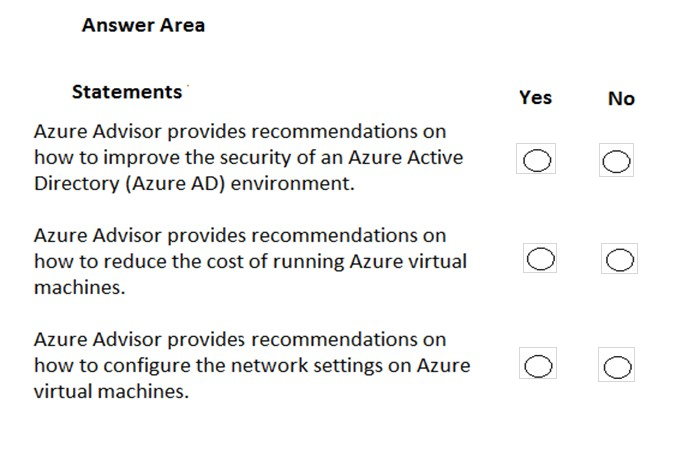
Correct Answer: 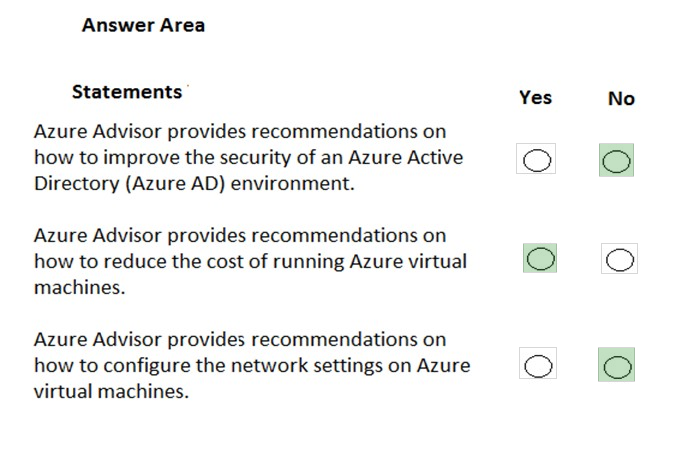
Box 1: No –
Azure Advisor provides you with a consistent, consolidated view of recommendations for all your Azure resources. It integrates with Azure Security Center to bring you security recommendations. You can get security recommendations from the Security tab on the Advisor dashboard. Examples of recommendations include restricting access to virtual machines by configuring Network Security Groups, enabling storage encryption, installing vulnerability assessment solutions.
However, Azure Advisor does not provide recommendations on how to improve the security of an Azure AD environment.
Box 2: Yes –
Advisor helps you optimize and reduce your overall Azure spend by identifying idle and underutilized resources. You can get cost recommendations from the Cost tab on the Advisor dashboard.
Box 3: No.
Azure Advisor does not provide recommendations on how to configure network settings on Azure virtual machines.
References:
https://docs.microsoft.com/en-us/azure/advisor/advisor-security-recommendations https://docs.microsoft.com/en-us/azure/advisor/advisor-cost-recommendations
Question #184Topic 1
Note: This question is part of a series of questions that present the same scenario. Each question in the series contains a unique solution that might meet the stated goals. Some question sets might have more than one correct solution, while others might not have a correct solution.
After you answer a question in this section, you will NOT be able to return to it. As a result, these questions will not appear in the review screen.
You have an Azure subscription named Subscription1. You sign in to the Azure portal and create a resource group named RG1.
From Azure documentation, you have the following command that creates a virtual machine named VM1. az vm create –resource-group RG1 –name VM1 –image UbuntuLTS –generate-ssh-keys
You need to create VM1 in Subscription1 by using the command.
Solution: From the Azure portal, launch Azure Cloud Shell and select PowerShell. Run the command in Cloud Shell.
Does this meet the goal?
- A. Yes
- B. No
Correct Answer: A
The command can be run in the Azure Cloud Shell. Although this question says you select PowerShell rather than Bash, the Az commands will work in
PowerShell.
The Azure Cloud Shell is a free interactive shell. It has common Azure tools preinstalled and configured to use with your account.
To open the Cloud Shell, just select Try it from the upper right corner of a code block. You can also launch Cloud Shell in a separate browser tab by going to https://shell.azure.com/bash.
Reference:
https://docs.microsoft.com/en-us/azure/virtual-machines/linux/quick-create-cli
Community vote distribution
B (51%)
A (49%)
Question #185Topic 1
Note: This question is part of a series of questions that present the same scenario. Each question in the series contains a unique solution that might meet the stated goals. Some question sets might have more than one correct solution, while others might not have a correct solution.
After you answer a question in this section, you will NOT be able to return to it. As a result, these questions will not appear in the review screen.
You have an Azure subscription named Subscription1. You sign in to the Azure portal and create a resource group named RG1.
From Azure documentation, you have the following command that creates a virtual machine named VM1. az vm create –resource-group RG1 –name VM1 –image UbuntuLTS
–generate-ssh-keys
You need to create VM1 in Subscription1 by using the command.
Solution: From a computer that runs Windows 10, install Azure CLI. From PowerShell, sign in to Azure and then run the command.
Does this meet the goal?
- A. Yes
- B. No
Correct Answer: A
The command can be run from PowerShell or the command prompt if you have the Azure CLI installed.
Reference:
https://docs.microsoft.com/en-us/cli/azure/install-azure-cli-windows?view=azure-cli-latest
Community vote distribution
A (69%)
B (31%)
Question #186Topic 1
Note: This question is part of a series of questions that present the same scenario. Each question in the series contains a unique solution that might meet the stated goals. Some question sets might have more than one correct solution, while others might not have a correct solution.
After you answer a question in this section, you will NOT be able to return to it. As a result, these questions will not appear in the review screen.
You have an Azure subscription named Subscription1. You sign in to the Azure portal and create a resource group named RG1.
From Azure documentation, you have the following command that creates a virtual machine named VM1. az vm create –resource-group RG1 –name VM1 –image UbuntuLTS
–generate-ssh-keys
You need to create VM1 in Subscription1 by using the command.
Solution: From a computer that runs Windows 10, install Azure CLI. From a command prompt, sign in to Azure and then run the command.
Does this meet the goal?
- A. Yes
- B. No
Correct Answer: A
The command can be run from PowerShell or the command prompt if you have the Azure CLI installed.
Reference:
https://docs.microsoft.com/en-us/cli/azure/install-azure-cli-windows?view=azure-cli-latest
Community vote distribution
A (71%)
B (29%)
Question #187Topic 1
HOTSPOT –
Several support engineers plan to manage Azure by using the computers shown in the following table:

You need to identify which Azure management tools can be used from each computer.
What should you identify for each computer? To answer, select the appropriate options in the answer area.
NOTE: Each correct selection is worth one point.
Hot Area:

Correct Answer: 
Previously, the Azure CLI (or x-plat CLI) was the only option for managing Azure subscriptions and resources from the command-line on Linux and macOS. Now with the open source and cross-platform release of PowerShell, you’ll be able to manage all your Azure resources from Windows, Linux and macOS using your tool of choice, either the Azure CLI or Azure PowerShell cmdlets.
The Azure portal runs in a web browser so can be used in either operating system.
Reference:
https://buildazure.com/2016/08/18/powershell-now-open-source-and-cross-platform-linux-macos-windows/
Question #188Topic 1
HOTSPOT –
To complete the sentence, select the appropriate option in the answer area.
Hot Area:
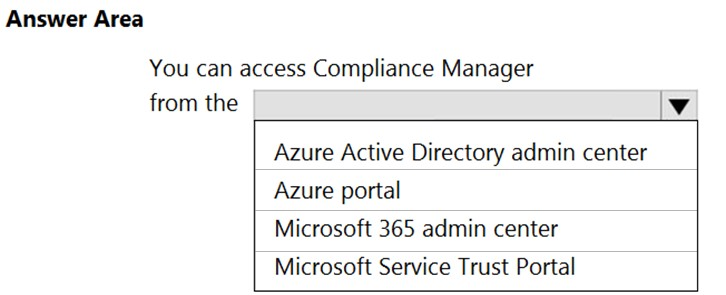
Correct Answer: 
Question #189Topic 1
HOTSPOT –
To complete the sentence, select the appropriate option in the answer area.
Hot Area:

Correct Answer: 
Azure Resource Manager templates provides a common platform for deploying objects to a cloud infrastructure and for implementing consistency across the
Azure environment.
Azure policies are used to define rules for what can be deployed and how it should be deployed. Whilst this can help in ensuring consistency, Azure policies do not provide the common platform for deploying objects to a cloud infrastructure.
Reference:
https://docs.microsoft.com/en-us/azure/governance/policy/overview
Question #190Topic 1
DRAG DROP –
Match the Azure service to the correct description.
Instructions: To answer, drag the appropriate Azure service from the column on the left to its description on the right. Each service may be used once, more than once, or not at all.
NOTE: Each correct selection is worth one point.
Select and Place:

Correct Answer: 
Box 1:
Azure Bot Services provides a digital online assistant that provides speech support.
Bots provide an experience that feels less like using a computer and more like dealing with a person – or at least an intelligent robot. They can be used to shift simple, repetitive tasks, such as taking a dinner reservation or gathering profile information, on to automated systems that may no longer require direct human intervention. Users converse with a bot using text, interactive cards, and speech. A bot interaction can be a quick question and answer, or it can be a sophisticated conversation that intelligently provides access to services.
Box 2:
Azure Machine Learning uses past trainings to provide predictions that have high probability.
Machine learning is a data science technique that allows computers to use existing data to forecast future behaviors, outcomes, and trends. By using machine learning, computers learn without being explicitly programmed.
Forecasts or predictions from machine learning can make apps and devices smarter. For example, when you shop online, machine learning helps recommend other products you might want based on what you’ve bought.
Box 3:
Azure Functions provides serverless computing functionalities.
Azure Functions is a serverless compute service that lets you run event-triggered code without having to explicitly provision or manage infrastructure.
Box 4:
IoT Hub (Internet of things Hub) provides data from millions of sensors.
IoT Hub is a managed service, hosted in the cloud, that acts as a central message hub for bi-directional communication between your IoT application and the devices it manages. You can use Azure IoT Hub to build IoT solutions with reliable and secure communications between millions of IoT devices and a cloud- hosted solution backend. You can connect virtually any device to IoT Hub.
References:
https://docs.microsoft.com/en-us/azure/bot-service/bot-service-overview-introduction?view=azure-bot-service-4.0 https://docs.microsoft.com/en-us/azure/machine-learning/overview-what-is-azure-ml https://docs.microsoft.com/en-us/azure/azure-functions/ https://docs.microsoft.com/en-us/azure/iot-hub/about-iot-hub
Question #191Topic 1
Note: This question is part of a series of questions that present the same scenario. Each question in the series contains a unique solution that might meet the stated goals. Some question sets might have more than one correct solution, while others might not have a correct solution.
After you answer a question in this section, you will NOT be able to return to it. As a result, these questions will not appear in the review screen.
An Azure administrator plans to run a PowerShell script that creates Azure resources.
You need to recommend which computer configuration to use to run the script.
Solution: Run the script from a computer that runs Windows 10 and has the Azure PowerShell module installed.
Does this meet the goal?
- A. Yes
- B. No
Correct Answer: A
A PowerShell script is a file that contains PowerShell cmdlets and code. A PowerShell script needs to be run in PowerShell.
In this question, the computer has the Azure PowerShell module installed. Therefore, this solution does meet the goal.
References:
https://docs.microsoft.com/en-us/powershell/scripting/components/ise/how-to-write-and-run-scripts-in-the-windows-powershell-ise?view=powershell-6
Community vote distribution
A (100%)
Question #192Topic 1
DRAG DROP –
Match the Azure services to the correct description.
Instructions: To answer, drag the appropriate Azure service from the column on the left to its description on the right. Each service may be used once, more than once, or not at all.
NOTE: Each correct selection is worth one point.
Select and Place:

Correct Answer: 
Box 1:
Azure virtual machines provide operation system virtualization.
Azure Virtual Machines (VM) is one of several types of on-demand, scalable computing resources that Azure offers. Typically, you choose a VM when you need more control over the computing environment than the other choices offer.
Box 2:
Azure Container Instances provide portable environments for virtualized applications.
Containers are becoming the preferred way to package, deploy, and manage cloud applications. Azure Container Instances offers the fastest and simplest way to run a container in Azure, without having to manage any virtual machines and without having to adopt a higher-level service.
Containers offer significant startup benefits over virtual machines (VMs). Azure Container Instances can start containers in Azure in seconds, without the need to provision and manage VMs.
Box 3:
Azure App Service is used to build, deploy and scale web apps.
Azure App Service is a platform-as-a-service (PaaS) offering that lets you create web and mobile apps for any platform or device and connect to data anywhere, in the cloud or on-premises. App Service includes the web and mobile capabilities that were previously delivered separately as Azure Websites and Azure Mobile
Services.
Box 4:
Azure Functions provide a platform for serverless code.
Azure Functions is a serverless compute service that lets you run event-triggered code without having to explicitly provision or manage infrastructure.
References:
https://docs.microsoft.com/en-us/azure/virtual-machines/windows/overview https://docs.microsoft.com/en-us/azure/security/fundamentals/paas-applications-using-app-services https://docs.microsoft.com/en-us/azure/azure-functions/ https://docs.microsoft.com/en-us/azure/container-instances/container-instances-overview
Question #193Topic 1
Which service provides serverless computing in Azure?
- A. Azure Virtual Machines
- B. Azure Functions
- C. Azure storage account
- D. Azure dedicated hosts
Correct Answer: B
Azure Functions provide a platform for serverless code.
Azure Functions is a serverless compute service that lets you run event-triggered code without having to explicitly provision or manage infrastructure.
Reference:
https://docs.microsoft.com/en-us/azure/azure-functions/
Community vote distribution
B (100%)
Question #194Topic 1
An Azure administrator plans to run a PowerShell script that creates Azure resources.
You need to recommend which computer configuration to use to run the script.
Which three computers can run the script? Each correct answer presents a complete solution.
NOTE: Each correct selection is worth one point.
- A. a computer that runs macOS and has PowerShell Core 6.0 installed.
- B. a computer that runs Windows 10 and has the Azure PowerShell module installed.
- C. a computer that runs Linux and has the Azure PowerShell module installed.
- D. a computer that runs Linux and has the Azure CLI tools installed.
- E. a computer that runs Chrome OS and uses Azure Cloud Shell.
Correct Answer: ABE
A PowerShell script is a file that contains PowerShell cmdlets and code. A PowerShell script needs to be run in PowerShell.
Reference:
https://docs.microsoft.com/en-us/powershell/scripting/components/ise/how-to-write-and-run-scripts-in-the-windows-powershell-ise?view=powershell-6 https://docs.microsoft.com/en-us/azure/cloud-shell/quickstart-powershell
Community vote distribution
BCE (93%)
2%
Question #195Topic 1
Note: This question is part of a series of questions that present the same scenario. Each question in the series contains a unique solution that might meet the stated goals. Some question sets might have more than one correct solution, while others might not have a correct solution.
After you answer a question in this section, you will NOT be able to return to it. As a result, these questions will not appear in the review screen.
You have an Azure subscription named Subscription1. You sign in to the Azure portal and create a resource group named RG1.
From Azure documentation, you have the following command that creates a virtual machine named VM1. az vm create –resource-group RG1 –name VM1 –image UbuntuLTS –generate-ssh-keys
You need to create VM1 in Subscription1 by using the command.
Solution: From the Azure portal, launch Azure Cloud Shell and select Bash. Run the command in Cloud Shell.
Does this meet the goal?
- A. Yes
- B. No
Correct Answer: A
The command can be run in the Azure Cloud Shell.
The Azure Cloud Shell is a free interactive shell. It has common Azure tools preinstalled and configured to use with your account.
To open the Cloud Shell, just select Try it from the upper right corner of a code block. You can also launch Cloud Shell in a separate browser tab by going to https://shell.azure.com/bash.
References:
https://docs.microsoft.com/en-us/azure/virtual-machines/linux/quick-create-cli
Community vote distribution
A (62%)
B (29%)
10%
Question #196Topic 1
Your company has several business units.
Each business unit requires 20 different Azure resources for daily operation. All the business units require the same type of Azure resources.
You need to recommend a solution to automate the creation of the Azure resources.
What should you include in the recommendations?
- A. Azure Resource Manager templates
- B. virtual machine scale sets
- C. the Azure API Management service
- D. management groups
Correct Answer: A
You can use Azure Resource Manager templates to automate the creation of the Azure resources. Deploying resource through templates is known as
‘Infrastructure as code’.
To implement infrastructure as code for your Azure solutions, use Azure Resource Manager templates. The template is a JavaScript Object Notation (JSON) file that defines the infrastructure and configuration for your project. The template uses declarative syntax, which lets you state what you intend to deploy without having to write the sequence of programming commands to create it. In the template, you specify the resources to deploy and the properties for those resources.
References:
https://docs.microsoft.com/en-us/azure/azure-resource-manager/templates/overview
Community vote distribution
A (100%)
Question #197Topic 1
HOTSPOT –
For each of the following statements, select Yes if the statement is true. Otherwise, select No.
NOTE: Each correct selection is worth one point.
Hot Area:

Correct Answer: 
Reference:
https://docs.microsoft.com/en-us/azure/cost-management-billing/costs/quick-acm-cost-analysis https://docs.microsoft.com/en-us/azure/cost-management-billing/costs/cost-analysis-common-uses
Question #198Topic 1
What can you use to identify underutilized or unused Azure virtual machines?
- A. Azure Advisor
- B. Azure Cost Management + Billing
- C. Azure reservations
- D. Azure Policy
Correct Answer: A
Azure Advisor helps you optimize and reduce your overall Azure spend by identifying idle and underutilized resources. You can get cost recommendations from the Cost tab on the Advisor dashboard.
Reference:
https://docs.microsoft.com/en-us/azure/advisor/advisor-overview
Community vote distribution
A (82%)
B (18%)
Question #199Topic 1
HOTSPOT –
Which node in the Azure portal should you use to assign a user the Reader role for a resource group? To answer, select the node in the answer area.
NOTE: Each correct selection is worth one point.
Hot Area:
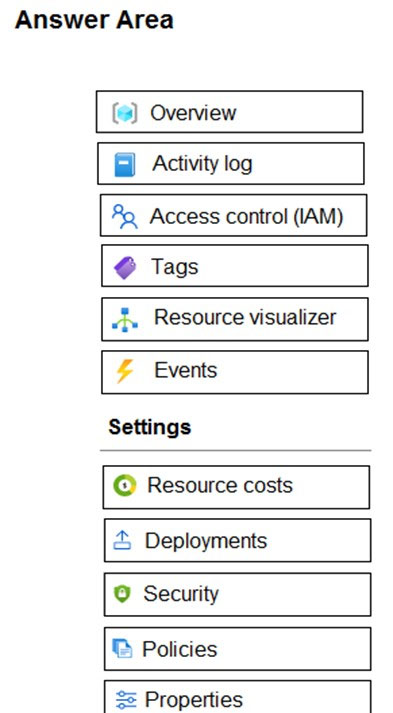
Correct Answer: 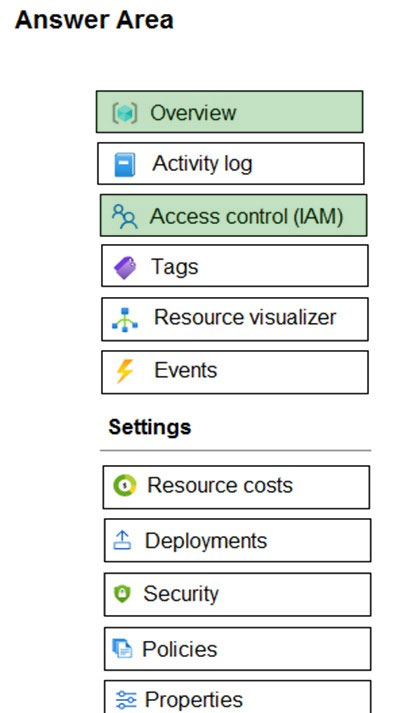
Box 1: Overview –
When you assign roles, you must specify a scope. Scope is the set of resources the access applies to. In Azure, you can specify a scope at four levels from broad to narrow: management group, subscription, resource group, and resource.
1. Sign in to the Azure portal.
2. In the Search box at the top, search for the scope you want to grant access to. For example, search for Management groups, Subscriptions, Resource groups, or a specific resource.
3. Click the specific resource for that scope.
4. The following shows an example resource group.
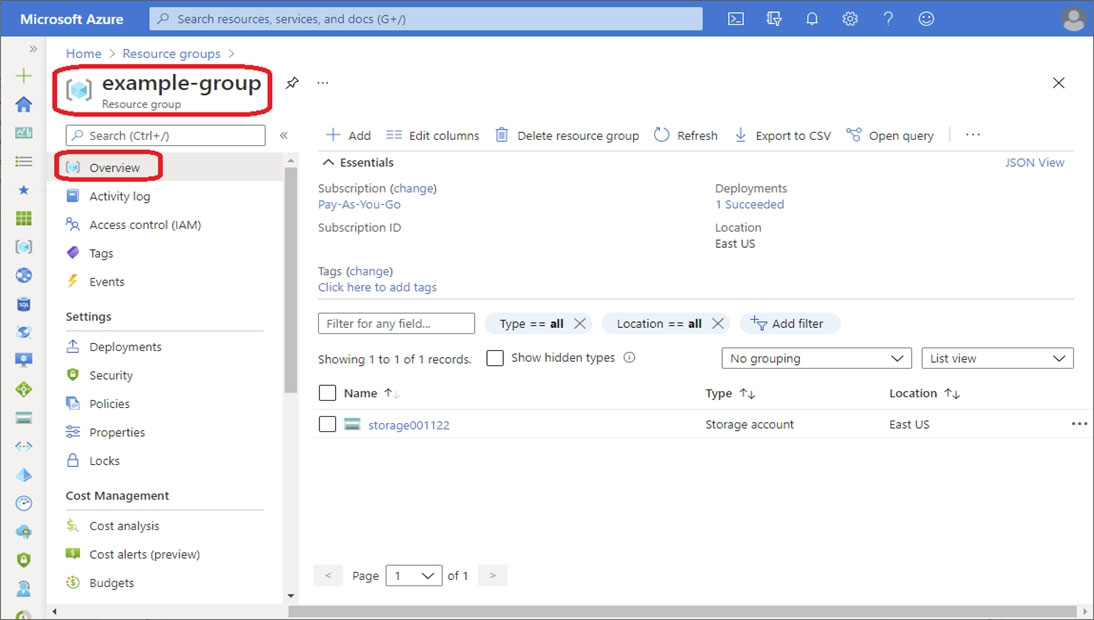
Box 2: Access control (IAM)
Access control (IAM) is the page that you typically use to assign roles to grant access to Azure resources. It’s also known as identity and access management
(IAM) and appears in several locations in the Azure portal.
1. Click Access control (IAM).
The following shows an example of the Access control (IAM) page for a resource group.
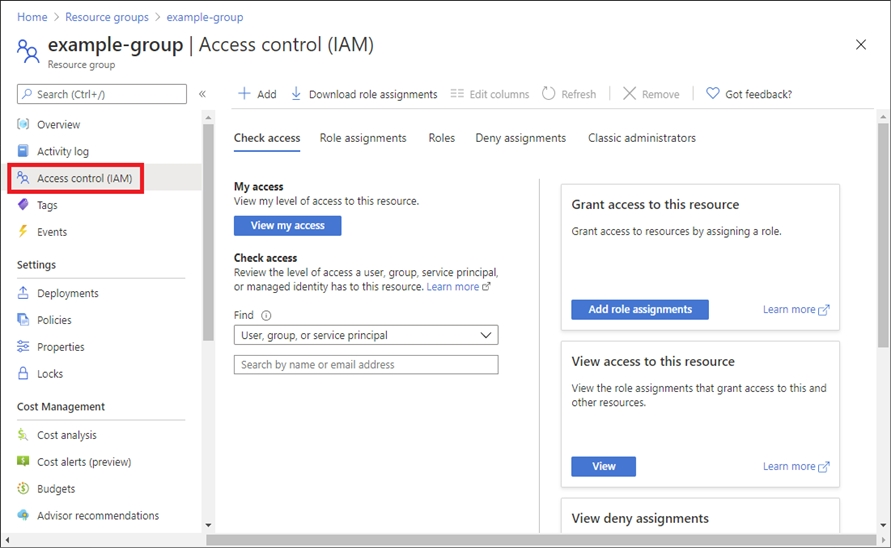
2. Click the Role assignments tab to view the role assignments at this scope.
3. Click Add > Add role assignment.
If you don’t have permissions to assign roles, the Add role assignment option will be disabled.
4. The Add role assignment page opens.
Reference:
https://docs.microsoft.com/en-us/azure/role-based-access-control/role-assignments-portal

